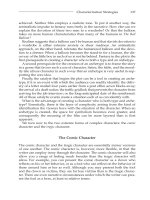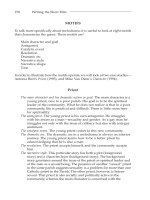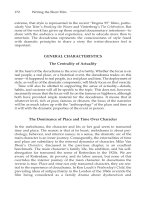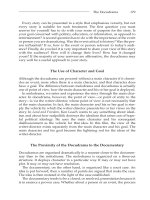Tài liệu Writing the short film 3th - Part 27 ppt
Bạn đang xem bản rút gọn của tài liệu. Xem và tải ngay bản đầy đủ của tài liệu tại đây (153.16 KB, 7 trang )
extreme, that style is represented in the recent “Dogma 95” films, partic-
ularly Von Trier’s Breaking the Waves and Vinterberg’s The Celebration. But
none of the work has given up those original documentary intentions—to
share with the audience a real experience, and to educate more than to
entertain. The docudrama represents the consciousness of style fused
with dramatic principles to share a story the writer-directors feel is
important.
GENERAL CHARACTERISTICS
The Centrality of Actuality
At the heart of the docudrama is the sense of actuality. Whether the focus is on
real people, a real place, or a historical event, the docudrama trades on this
sense—it happened to real people, in a real place and time. The deployment of
style, as well as of the dramatic components, will likely focus on that veracity.
Time will also be allotted to supporting the sense of actuality—details,
habits, and customs will all be specific to the topic. This does not, however,
necessarily mean that the focus will be on the famous or highborn, although
both have provided ample material for the docudrama. It means that at
whatever level, rich or poor, famous or obscure, the focus of the narrative
will be as much taken up with the “anthropology” of the place and time as
it will with the dramatic properties of the event or person.
The Dominance of Place and Time Over Character
In the melodrama, the character and his or her goal seem to transcend
time and place. The reason is that at its heart, melodrama is about psy-
chology, behavior, and interior issues; in a sense, the dramatic arc of the
main character is an inner journey. Consequently, the externalities of time
and place are subsidiary to the internal dynamics of character. Mike Van
Diem’s Character, discussed in the previous chapter, is an excellent
benchmark. The main character’s family life, his ambition, and his self-
abnegation far transcend the sense of Rotterdam in the 1920s. We are
aware of Rotterdam, its poverty, and its labor unrest, but none of this
overrides the interior journey of the main character. In docudrama the
reverse is true. Place and time not only transcend character, they are cen-
tral to the experience of docudrama. In Ken Loach’s Wednesday’s Child, the
prevailing ideas of antipsychiatry in the London of the 1960s override the
film being considered as a family drama about dysfunction and
172 Writing the Short Film
Ch14.qxd 9/27/04 6:10 PM Page 172
child–parent relationships. Equally, Michael Ritchie’s Downhill Racer
is more about competitive international sports in the 1970s than it is
about a particular skier. Why this is the case has everything to do with the
goals of the writer or director, an issue we will address later in this sec-
tion.
The Nature of the Struggle of the Main Character
The struggle for the main character in melodrama dominates the narrative.
In the docudrama, the nature of the character’s struggle is subordinate to
the goal of the story. In addition, here the voice of the author subsumes the
elements of story, often for political (as opposed to dramatic) purposes.
Also, the heritage of the documentary film overrides dramatic considera-
tions. In Karel Reisz’s Saturday Night and Sunday Morning, the challenge of
conformity is more critical than the character’s fate, and something similar
is true of Tony Richardson’s The Loneliness of the Long Distance Runner. The
idea of female oppression at the hands of male chauvinism far supersedes
the portrait of Camille Claudel as an artist in Bruno Nuytten’s Camille
Claudel; further, place and time—turn-of-the-century Paris and its art
world—are more critical than the personal relationship between Claudel
and Rodin.
The Role of Plot
In the melodrama, plot (if deployed) is a primary barrier to the main char-
acter and his or her goal. If the main character and the goal are less impor-
tant in the docudrama, how is plot used? In Peter Watkin’s Culloden,
the battle itself, the last battle fought on British soil, dominates the narra-
tive. Although there are many characters on both sides of the battle,
their vividness does not dominate the story; indeed, there is no single
main character. The course of the event, which is the plot, dominates the
narrative.
This dynamic does not change when Watkins takes a character as his
subject. In his film Edvard Munch, the goal of the main character is to pur-
sue his artistic goals. His early career in Norway and Germany is a failure,
because of the powerful conservatism of the German art critics. Although
Munch finds alliances with other artists and writers, the course of his
career, the plot, has a tragic quality. Here too plot seems more important
than the interior emotional journey of Munch (so often reflected in his
own paintings).
The Docudrama 173
Ch14.qxd 9/27/04 6:10 PM Page 173
The Relationship of Docudrama to Issues of the Day
Like melodrama, the docudrama is eminently adaptable to the issues of the
day. Because as a style it gives the viewer the sense of being there as the
story is unfolding, the style evokes the power of television with its imme-
diacy. Consequently, films such as The Death of a Princess are particularly
powerful. Much of Ken Loach’s work, from Poor Cow to Riff Raff, has this
quality. The docudrama also lends weight to past events, special events,
and famous people of the past. Steven Spielberg’s techniques for the open-
ing battle scene of Saving Private Ryan borrow extensively from the style of
the docudrama. He has used the approach not only to memorialize the
D-day landings on the beaches of Normandy but also to give us the feeling
that we are on those beaches.
The docudrama form is particular and elicits a very specific kind of reac-
tion from its audience. It lends an immediacy to events past and present, an
immediacy that is quite unique in its impact on the audience.
The Voice of the Author
Although one interpretation of docudrama is to call it simply classical melo-
drama with a distinctive style, this is too circumscribed a definition to
encompass docudrama fully. Another view is to call docudrama a story form
that, by virtue of the author’s strongly held views, requires a style powerful
enough to act as a pronouncement of those views. To put it more simply,
docudrama is a form in which it is important to the author to say to the audi-
ence, “This story is more important than your average melodrama. I have
something to say, and I want you to listen and to watch and to be moved to
action by the experience.”
In this sense, the choice of a docudrama approach in a film such as Ken
Loach’s Land and Freedom, with its cinema verité style, gives us the sense that
we are there on the Republican side during the Spanish Civil War. The style
gives a feeling of immediacy to the combat scenes, but the docudrama form
also has an impact on the narrative choices Loach makes. On at least three
occasions during the film, lengthy debates take place about issues that are in
essence matters of dogma: land rights; the role of the Soviet Communist
Party and Joseph Stalin in the organization of the Republican side; and mil-
itary organization—whether formal structure would undermine the para-
military units, which are presented as ideologically “pure” and therefore
true revolutionaries. These lengthy discussions are filmed earnestly and
respectfully, as if they were just happening. From a dramatic point of view,
these choices make the experience of the film more educational than “emo-
tional,” as melodramatic equivalents (The Sun Also Rises and For Whom the
Bell Tolls) would tend to be.
174 Writing the Short Film
Ch14.qxd 9/27/04 6:10 PM Page 174
When they wish to achieve a more active voice—a voice that implies a
higher level of importance, serving an educational or political goal rather
than entertainment—directors choose the docudrama, a form whose style
implies, “This is important.”
MOTIFS—CASE STUDIES
For docudrama, as for melodrama, it is useful to look at case studies in order
to understand the narrative shape of the form. The two case studies below
will represent two of the subcategories of the docudrama: the event, Peter
Watkins’s Culloden (1964); and the political portrait, Ken Loach’s Land and
Freedom (1996).
Culloden
The Main Character and His Goal
The story proceeds without a main character. The combatants are the
Scottish and the English. The leadership in each case is highlighted; how-
ever, there is no single character through whom we enter the story. If there is
the equivalent of a main character, it is the narrator, in essence a reporter in
search of the story. He interviews combatants, the victors as well as the van-
quished. He is looking to explain as well as to understand the battle and its
aftermath. In this sense, the narrator could be considered the main character,
with the goal of reporting the story of the last battle to occur on British soil.
The narrator, by the way, is Peter Watkins himself. Using the form of the
docudrama, he has made himself, and his voice about the battle, the entry
point (which is the role of the main character) into the story.
The Antagonist
The antagonist in this story is certainly the imperial forces, from the com-
mander, Prince William of England, down to the English soldiers. They are
portrayed as cruel, lusting for Scottish blood. Although Prince Charles, who
leads the Scottish rebellion, is rebuked for his indifference to his forces and
for his addiction “to his little bottle,” he is presented as no worse than an
incapable leader of the disunited, underarmed forces that meet the English
on the field at Culloden.
The Catalytic Event
Since the entire film is devoted to the events leading up to the battle, the bat-
tle itself, and its aftermath, the catalytic event would have to be considered
The Docudrama 175
Ch14.qxd 9/27/04 6:10 PM Page 175
the beginning of the Scottish rebellion that has resulted in the battle.
Whether this is the landing of “Bonnie Prince Charlie” from France or some
subsequent political coalition, the fact is that the catalytic event, unusual as
it is, occurs before the film begins.
The Dramatic Arc
The shape of Culloden is the course of the battle itself. There is a lead-up to
the battle, and there is an aftermath. However, the major part of the narra-
tive is devoted to the battle itself, its details, and its outcome.
The Resolution
The battle ends with a decisive victory for the English forces. In the after-
math of the battle, the Scottish wounded on the field of battle are executed,
and those who are captured are transported for execution in the cities of
England or deported to Australia.
The Narrative Style
Culloden is entirely plot. We follow the course of a battle from beginning to
end. Since there is no central character, relationships are not developed.
Characters are introduced only in terms of their roles in the battle. Their per-
formance and their fates are reported in the narrative.
The Narrative Shape
Because Culloden is about a battle, time is important. The film illustrates how
quickly and decisively the English forces were able to win the battle. Time
also plays a role in how remorselessly and cruelly the vanquished were
hunted down and punished for participating in the Scottish rebellion.
Tone
The battle is presented in a cinema verité style. Details of social, economic,
and military organization and weaponry are combined with journalistic
interviews with the combatants. The presentation is extremely realistic.
The narrator, the writer-director Watkins, has clear sympathies for Scottish
nationalism; consequently, he editorializes about the English leadership
and forces in the harshest terms. It is his view that this last battle on
English soil destroyed a culture, the remnants of which were dispersed to
the far corners of the Empire as a result. The tone of the narration is one of
176 Writing the Short Film
Ch14.qxd 9/27/04 6:10 PM Page 176









